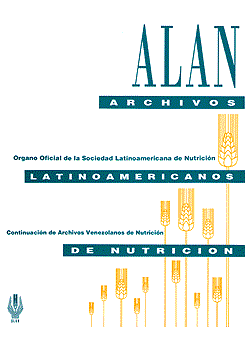Efectividad del índice de masa corporal en el diagnóstico nutricional de las gestantes adolescentes
Keywords:
Embarazada, Adolescente, Antropometría, Índice de Masa Corporal, Criterios, Pregnant, Anthropometry, Tennage, Body Mass Index, Classification CriteriaAbstract
Con el fin de analizar la capacidad diagnóstica del estado nutricional de diferentes criterios de clasificación basados en el índice de masa corporal y evaluar su efectividad se estudiaron 367 gestantes adolescentes, sanas, en el primer trimestre de gestación, de estrato socioeconómico IV, entre octubre 1999 y diciembre 2008. Se aplicaron dos metodologías para la clasificación nutricional: 1. Diagnóstico nutricional integral (patrón de oro), 2. Índice de masa corporal (IMC) utilizando valores de referencia nacionales: Proyecto Venezuela y Estudio Transversal de Caracas, e internacionales: Frisancho y OMS 2006. Se calcularon concordancias, kappa, sensibilidad, especificidad, valor predictivo positivo y negativo, razón de verosimilitud positiva y negativa e índice Youden. El porcentaje de gestantes eutróficas según patrón de oro e IMC osciló entre 62,4% y 80,6%. En el rango de déficit, Frisancho resultó el más efectivo con kappa: 0,80, sensibilidad: 87,3%; especificidad: 94,8%; razón de verosimilitud positiva: 16,9 y negativa: 0,13; índice Youden: 0,82. En el rango de exceso Frisancho y Estudio Transversal de Caracas resultaron los más efectivos, índice Youden 0,86 y 0,83, respectivamente. Según estos resultados Frisancho resultó el mejor criterio para diagnosticar malnutrición por déficit en gestantes. Todas las referencias tienen una capacidad diagnóstica adecuada en el rango de exceso, siendo los mejores Frisancho y Estudio Transversal de Caracas. Se recomienda el uso de dichos valores de referencia para optimizar la eficacia del indicador IMC en el diagnóstico de malnutrición por déficit y por exceso en gestantes adolescentes en el primer trimestre de la gestación en poblaciones con características similares.
The purpose of this study was to analyze the diagnostic capacity of different classification criteria based on Body Mass Index in the assessment of nutritional status and to evaluate their effectiveness. The sample comprised 367 healthy pregnant adolescents in their first trimester of gestation, from a socioeconomic level IV, between Oct. 1999 and Dec. 2008. Two methodologies were applied for the nutritional classification: 1. Integral nutritional diagnosis (gold standard), and 2. Body Mass Index (BMI), using local reference values: Proyecto Venezuela and the Transversal Study of Caracas, and international reference values: Frisancho and WHO 2006. Concordances, kappa, sensitivity, specificity, positive and negative predictive values, positive and negative likelihood ratios, and the Youden index were calculated. According to the gold standard and BMI, the percentage of wellnourished pregnant women ranged between 62.4% and 80.6%. Within the deficit range, Frisancho was the most effective with kappa: 0.80; sensitivity: 87.3%; specificity: 94.8%; positive likelihood ratio: 16.9, and negative likelihood ratio: 0.13; Youden index: 0.82. Within the excess range, Frisancho and the Transversal Study of Caracas were the most effective with Youden index: 0.86 and 0.83, respectively. These results revealed that Frisancho was the best criterion to diagnose malnutrition in deficit in pregnant women. All references have an adequate diagnostic capacity for the excess range, of which Frisancho and the Transversal Study of Caracas are the best. We recommend using such reference values to optimize the efficiency of the BMI indicator in diagnosing malnutrition in deficit and in excess in the first trimester of gestation in pregnant adolescents within populations with similar characteristics.
Downloads
Downloads
How to Cite
Issue
Section
License
Usted es libre de:
Compartir — copiar y redistribuir el material en cualquier medio o formato
Adaptar — remezclar, transformar y construir a partir del material
La licenciante no puede revocar estas libertades en tanto usted siga los términos de la licencia
Bajo los siguientes términos:
Atribución — Usted debe dar crédito de manera adecuada, brindar un enlace a la licencia, e indicar si se han realizado cambios. Puede hacerlo en cualquier forma razonable, pero no de forma tal que sugiera que usted o su uso tienen el apoyo de la licenciante.
NoComercial — Usted no puede hacer uso del material con propósitos comerciales.
No hay restricciones adicionales — No puede aplicar términos legales ni medidas tecnológicas que restrinjan legalmente a otras a hacer cualquier uso permitido por la licencia.




